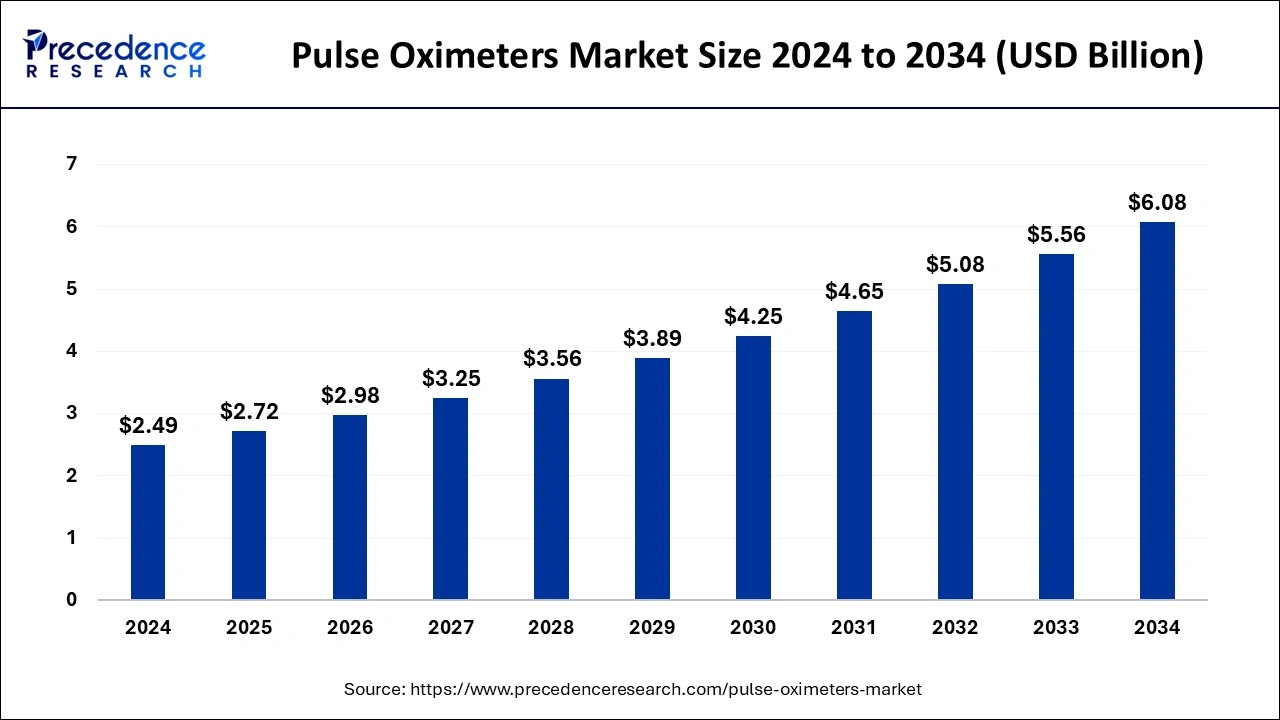The global pulse oximeters market is valued at USD 2.49 billion in 2024 and is projected to reach USD 6.08 billion by 2034, growing at a CAGR of 9.33%

Pulse Oximeters Market Key Takeaways
- North America dominated the market with a 49% share in 2024.
- The hospitals segment led the market by end-use in 2024.
- The home healthcare segment is projected to grow at the fastest CAGR over the forecast period.
- Among product types, tabletop oximeters held the largest market share in 2024.
Overview
The pulse oximeters market has witnessed significant growth due to increasing awareness about respiratory health and the rising prevalence of conditions such as chronic obstructive pulmonary disease (COPD), asthma, and cardiovascular diseases. Pulse oximeters are non-invasive medical devices that measure oxygen saturation levels in the blood and pulse rate, making them essential for patient monitoring in hospitals, clinics, and homecare settings. The demand for these devices surged during the COVID-19 pandemic, as healthcare systems prioritized continuous monitoring of oxygen levels in infected patients.
Technological advancements, including the development of wireless and wearable pulse oximeters, are further driving market expansion. Additionally, the growing adoption of telemedicine and remote patient monitoring solutions is fueling the demand for portable and user-friendly pulse oximeters.
Drivers
Several factors are contributing to the growth of the pulse oximeters market. The increasing global burden of respiratory diseases and cardiovascular conditions has led to a higher demand for continuous oxygen monitoring devices. The aging population, which is more susceptible to chronic illnesses, is also driving market growth. Additionally, the shift towards home-based healthcare and self-monitoring devices has increased the adoption of portable pulse oximeters. Regulatory support and government initiatives aimed at improving healthcare accessibility have further boosted market expansion. Moreover, advancements in sensor technology and the integration of artificial intelligence in medical devices are enhancing the accuracy and efficiency of pulse oximeters, making them more reliable for both clinical and personal use.
Opportunities
The pulse oximeters market presents numerous growth opportunities, particularly with the rising adoption of telehealth and remote patient monitoring solutions. The increasing penetration of wearable health devices, such as smartwatches and fitness trackers equipped with pulse oximetry sensors, is expected to drive demand. Additionally, the expansion of healthcare infrastructure in emerging economies is creating new opportunities for market players to introduce cost-effective and portable pulse oximeters. The growing focus on early disease detection and preventive healthcare is also fueling interest in continuous monitoring devices. Furthermore, collaborations between medical device manufacturers and digital health companies are leading to the development of innovative oximetry solutions with real-time data analytics and cloud connectivity.
Challenges
Despite its promising growth, the pulse oximeters market faces several challenges. The accuracy and reliability of pulse oximeters can be affected by factors such as skin pigmentation, poor circulation, and motion artifacts, raising concerns about their effectiveness in certain patient populations. Regulatory compliance and stringent approval processes for medical devices can also delay product launches and increase manufacturing costs. The presence of low-cost, unregulated pulse oximeters in the market poses a challenge for established players, as consumers may opt for inexpensive alternatives that lack accuracy and quality standards. Additionally, limited awareness about proper device usage and interpretation of readings in developing regions remains a challenge for market expansion.
Regional Insights
North America currently dominates the pulse oximeters market, driven by advanced healthcare infrastructure, high adoption rates of medical technology, and increased awareness about respiratory health. The United States, in particular, has witnessed significant demand for pulse oximeters due to a rise in home healthcare and remote patient monitoring services. Europe follows closely, with growing investments in healthcare innovation and government initiatives promoting digital health solutions.
The Asia-Pacific region is experiencing rapid market growth, fueled by an expanding patient population, improving healthcare access, and increasing adoption of wearable health devices. Countries such as China and India are emerging as key markets due to rising healthcare spending and the growing prevalence of chronic diseases. Latin America and the Middle East & Africa are also witnessing steady growth, supported by healthcare modernization efforts and increasing awareness of respiratory health monitoring.
Recent News
The pulse oximeters market has seen several key developments in recent months. Leading medical device companies have launched advanced pulse oximeters with improved accuracy, wireless connectivity, and real-time data tracking capabilities. Regulatory agencies are revising guidelines to ensure the reliability and accuracy of pulse oximeters, particularly in consumer-grade devices. The integration of pulse oximetry technology into smartwatches and fitness trackers has gained traction, with major technology firms entering the healthcare space.
Additionally, increased investment in digital health and telemedicine platforms has led to new partnerships between pulse oximeter manufacturers and healthcare providers to enhance remote patient monitoring solutions. The market is also seeing efforts to address disparities in oximeter accuracy among different patient populations, with ongoing research focusing on sensor calibration and AI-driven data analysis.
Pulse Oximeters Market Companies
- Smiths Group plc.
- Halmaplc
- Koninklijke Philips N.V.
- Medtronic plc
- Nihon Kohden Corporation
- Masimo Corporation
- Contec Medical Systems Co., Ltd.
Segments Covered in the Report
By Product Type
- Handheld Oximeters
- Fingertip Oximeters
- TabletopOximeters
By End-user
- Ambulatory Surgical Centers
- Hospitals
- Home Healthcares
By Regional Outlook
- North America
- U.S.
- Canada
- Europe
- U.K.
- Germany
- France
- Asia Pacific
- China
- India
- Japan
- South Korea
- Rest of the World